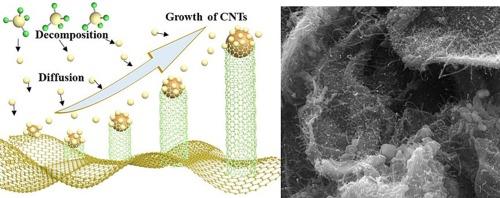The entangled CNT anchoring in graphene using CVD approach for intelligent absorbing materials with thermal sensitivity effect
IF 8.1
2区 材料科学
Q1 ENGINEERING, MANUFACTURING
Composites Part A: Applied Science and Manufacturing
Pub Date : 2025-09-18
DOI:10.1016/j.compositesa.2025.109311
引用次数: 0
Abstract
Single-type carbon material is often limited in its application in the field of intelligent absorption due to their lack of outstanding performance. However, traditional physical mixing methods are difficult to achieve effective interface bonding and multifunctional coupling of carbon materials. Here, we developed an effective method to prepare the entangled CNTs anchoring in graphene for intelligent absorbing materials possessing thermal sensitivity effect combing hydrothermal and CVD methods. Interestingly, ultrafine CNTs with diameter below 18 nm catalyzed from Fe/Co nanocrystals well dispersed on rGO surfaces. The as-designed dielectric rGO-CNTs hybrids strongly bonding with magnetic Fe/Co catalyst have the excellent microwave absorption performance. The RLmin value of the −37.7 dB at thickness of 1.6 mm is obtained for rGO-CNTs, which is better than pure carbon materials. Furthermore, this rGO-CNTs microwave absorbing materials also possess thermal sensitivity effect. The linear fitted relationship of (R-R0)/R0 −temperature is found with the slope of 0.2 %/°C, showing the regular and steady trends. It indicates a highly thermal sensitive feature has great potential for intelligent absorbing materials. This study opens a novel pathway for ultrafine CNTs entangled with graphene enhancing its high-performance microwave absorption coupled with thermal sensitivity effect.

利用CVD方法将碳纳米管在石墨烯中进行纠缠锚定制备具有热敏效应的智能吸波材料
单型碳材料由于缺乏突出的性能,往往限制了其在智能吸收领域的应用。然而,传统的物理混合方法难以实现碳材料的有效界面键合和多功能耦合。本研究将水热法和气相沉积法相结合,开发了一种有效的方法来制备具有热敏效应的智能吸收材料的石墨烯中缠绕的碳纳米管锚定。有趣的是,直径小于18 nm的超细碳纳米管由Fe/Co纳米晶体催化而成,分散在氧化石墨烯表面。与磁性Fe/Co催化剂强结合的介电rGO-CNTs杂化物具有优异的微波吸收性能。在厚度为1.6 mm时,rGO-CNTs的RLmin值为−37.7 dB,优于纯碳材料。此外,该rGO-CNTs吸波材料还具有热敏效应。(R-R0)/R0−温度的线性拟合关系斜率为0.2% /°C,表现出规律和稳定的趋势。这表明高热敏特性在智能吸波材料中具有很大的潜力。本研究为超细碳纳米管与石墨烯的纠缠开辟了一条新的途径,增强了其高性能的微波吸收和热敏效应。
本文章由计算机程序翻译,如有差异,请以英文原文为准。
求助全文
约1分钟内获得全文
求助全文
来源期刊

Composites Part A: Applied Science and Manufacturing
工程技术-材料科学:复合
CiteScore
15.20
自引率
5.70%
发文量
492
审稿时长
30 days
期刊介绍:
Composites Part A: Applied Science and Manufacturing is a comprehensive journal that publishes original research papers, review articles, case studies, short communications, and letters covering various aspects of composite materials science and technology. This includes fibrous and particulate reinforcements in polymeric, metallic, and ceramic matrices, as well as 'natural' composites like wood and biological materials. The journal addresses topics such as properties, design, and manufacture of reinforcing fibers and particles, novel architectures and concepts, multifunctional composites, advancements in fabrication and processing, manufacturing science, process modeling, experimental mechanics, microstructural characterization, interfaces, prediction and measurement of mechanical, physical, and chemical behavior, and performance in service. Additionally, articles on economic and commercial aspects, design, and case studies are welcomed. All submissions undergo rigorous peer review to ensure they contribute significantly and innovatively, maintaining high standards for content and presentation. The editorial team aims to expedite the review process for prompt publication.
 求助内容:
求助内容: 应助结果提醒方式:
应助结果提醒方式:


